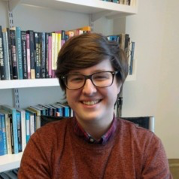By Timothy Bussey
After some discussions about my most recent post for this blog, there was some interest in how I was planning to incorporate LGBTQ diversity into a course, POLS 2072Q: Quantitative Analysis in Political Science. In this post, I’ll discuss three major points to consider when designing your quantitative course, though it should be noted that LGBTQ inclusion for each Q-course may look quite different. With that being said, the points listed below should be considered potential starting points to better support LGBTQIA+ diversity in your own classroom.
First, I’ll briefly mention that I’m specifically aiming to incorporate LGBTQ, rather than LGBTQIA+, diversity into the curriculum for this Q-course. This limitation exists because of the lack of readily available quantitative data on social and political issues affecting intersex and asexual persons, in addition other individuals in the broader LGBTQIA+ community. Second, I’ve tried to communicate some of my own ideas for implementing LGBTQ diversity into a quantitative course, but it should be noted that I largely come from a social science perspective. With that being said, instructors in some of the ‘hard sciences’ or other STEM courses may also wish to look for other resources, such as those offered by GLSEN.

- Break out of bimodal analyses, when possible.
For most instructors of statistics-orientated classes, we are very comfortable with the phrase, ‘bimodal analysis.’ When trying to incorporate LGBTQ diversity into a Q-course, we should challenge ourselves to break out of this mentality, when possible. For instance, we should consider who is automatically excluded when we ask for someone to list their sex as ‘male’ or ‘female’—a concept that many survey designers often conflate with gender. Instead, we should realize that our survey design may fail to distinguish a respondent’s sex assigned at birth from their gender identity. Additionally, we should also realize that this bimodal analysis often excludes both intersex and transgender data from being collected and/or analyzed in the first place. Breaking down this binary in our Q-courses can lead to a productive conversation about bettering transgender inclusion and recognizing common methodological flaws that negatively impact this inclusion. Breaking out of these bimodal analyses can also allow us to question what results quantitative data may yield, especially when we also consider diversity on the basis of sexuality, gender identity, and gender expression in relation to other demographic categories. For more information on breaking out of bimodal analyses in relation to gender diversity, you may find other resources, like those offered by the Williams Institute of the UCLA School of Law, quite useful.
- Incorporate examples, case studies, and datasets with LGBTQ diversity in mind.
Depending on the topic, there may be numerous ways to incorporate LGBTQ diversity into your Q-course. This can be done by way of examples, case studies, datasets, and discussions about historical figures of importance to your course. In POLS 2072Q, I am assigning a text, LGBTQ Stats: Lesbian, Gay, Bisexual, Transgender, and Queer People by the Numbers (2017). This text highlights LGBTQ statistics in reference to the law, public opinion, the workplace, healthcare, etc., and the students will use this as a starting point to find, explore, and analyze a particular topic and dataset of interest for a group presentation. In essence, the students will use this text to explore a particular sociopolitical issue relating to the LGBTQ community, and they will collaboratively work to apply their own analysis to a particular topic/dataset. This project seeks to expand the quantitative skillsets that we will develop throughout the term, but it will also encourage their engagement with diverse populations, while also providing them with collaborative public speaking experience too. In other disciplines with Q-courses, you may consider a similar approach to incorporating LGBTQ diversity into your class.
As a starting point, instructors may wish to brainstorm inclusive strategies after referring to Gallup and/or Pew, as they actively collect data pertaining to the LGBTQ community. As you may have noticed, LGBTQ inclusion can generally be more straightforward in statistics classes. With other courses, incorporating LGBTQ examples and case studies may look different. For example, the instructor of a computer science class may wish to highlight queer historical figures of interest, such as Alan Turing—the gay computer scientist who cracked Germany’s Enigma Code in World War II.
For other STEM or Q-courses, you may need to do more research or creative thinking, but much of this depends on the scope of the course and the method of instruction as well.
- Conscientiously consider how you can continue to bring LGBTQ diversity into your Q-course.
My final word of advice for better incorporating LGBTQ diversity into your Q-course would be that we, as instructors, should actively and conscientiously consider how we can bring more diversity into our classes. As mentioned previously, the inclusion of LGBTQ topics and issues will be more straightforward for some courses than others. Despite this, there is almost always something that we can do to bring this type of diversity into our classroom. For instructors who are having difficulties identifying where and how to bring LGBTQ diversity into a Q-course, take some time—possibly even a semester—to conscientiously think about ways that you could incorporate this into your class. It may also help to collaborate and communicate with other instructors who have already been moving towards a more inclusive model in their Q-courses. Remember that this process does take time, and the success that you and your students will see is an upward trend. In other words, my hope is that instructors will actively consider how to bring LGBTQ diversity into their Q-courses, but the rate at which this happens may be different for each instructor, course, and discipline. For more thoughts on how to bring LGBTQ diversity into a STEM or Q-course, it may also prove useful to check out the resources sponsored by oSTEM, a national organization that seeks to increase the inclusion of LGBTQIA+ persons in STEM fields.